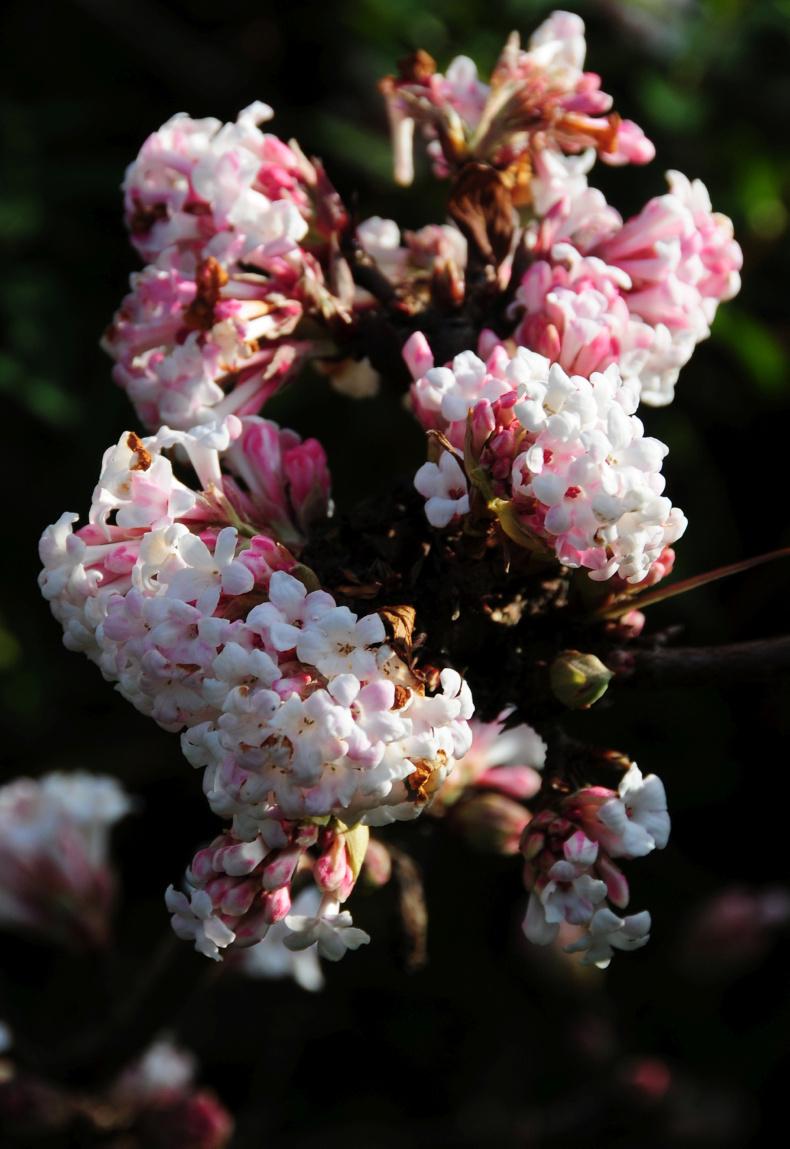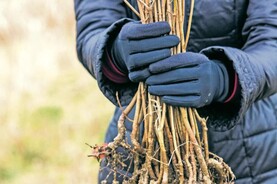The lovely autumn viburnum has had the best show of flower on it in living memory. This autumn kind is followed by winter viburnum, or laurustinus, which starts to flower in early winter and the main show finishes in April.
This is overtaken by spring viburnums and then there are the still-popular snowball bushes, guelder roses and wedding cake viburnums, all flowering in early summer. There is a gap of flowering between early summer and late autumn, but some kinds such as the guelder roses and some wedding cake trees fill the autumnal gap with berries – and practically all the deciduous kinds show good autumn colour. It is a parade of species of great decorative value.
The fragrant viburnum, viburnum farreri, and the bodnant viburnum came into flower just before the last leaves were shed, as is usual, but what was most unusual were the massive numbers of clustered tubular flowers, pink in bud and opening to white. These little flower clusters have a powerful, rich scent that carries on a warm breeze and a few sprigs will fill the house. It continues to flower when the leaves fall and the little clusters of flowers are carried along bare branches.
The Bodnant hybrid of this shrub, viburnum bodnantense, Dawn, has become popular because of its larger, darker-pink flowers, carried also on bare branches. Flowering tails off when the weather gets really chilly, but they open more flowers in good spells of weather in winter and the final lot in spring.

Viburnum.
The winter viburnum, or laurustinus, Viburnum tinus, is well known but relatively little value is put on it for a plant that flowers in winter and has very good foliage all year round. During late winter the flowers begin to open and peak in early spring. It is native to hilly areas of the Mediterranean region, growing at some altitude so it is quite hardy. This is a woodland plant — its dark leaves allow it to tolerate quite deep shade, but it flowers better in good light.
There is a lovely variegated form of the laurustinus, viburnum tinus, one of the most outstanding variegated plants. Its leaves are edged with cream, which can spread over either surface of the leaf, resulting in a patchwork of green, grey-green and cream-yellow.
The bark of the twigs is red and the flower buds are red before they open, which is a truly lovely effect. This form is not as vigorous as the green one.
The spring-flowering viburnums are smaller in size, such as viburnum carlesii and viburnum carlcephalum, that have rounded flowers of small tubular florets.
The former is the prettier, not as large or as vigorous and with smaller flowerheads that are more open in appearance. Its perfume is not as heavy either. A related and lovely hybrid is viburnum x juddii, early to flower as the leaves just break bud and more white in colour, with dense flowers that really stand out in the bare spring garden.
The wedding cake viburnums follow the spring kinds. These make large, broad, flat-topped bushes and are mostly varieties or hybrids of viburnum plicatum. The best known of these is probably Mariesii, superb in flower in June, with tiers of frothy white flowers. Smaller, but flowering continuously from spring to late autumn, is Nanum Semperflorens. It carries flushes of flowers and is an excellent garden shrub.
There are several other good viburnums, such as the snowball tree. All of these shrubs are easy to grow. Most of them grow to good size.
They are well suited to country gardens because of their natural look. Viburnums are easy to grow in any kind of soil that is not very heavy and wet in winter.

Compost heap.
Breaking the green bridge
The ‘green bridge’ refers to the carry-over of pests and diseases from year to year. Winter survival provides a major barrier to all pests and diseases, but most form eggs or spores that often carry over on old crops that are useless but still living.
The vegetable plant continues to act as host to the pest or disease and these constitute the ‘green bridge’.
For example, potato blight, white rot on onions, white blister and club root on cabbage, aphids on cabbage and rust on geraniums are carried over.
Old crops with leaves can be composted, but root diseases may survive composting and crops carrying root-borne diseases can? be disposed of by burying away from the vegetable ground.
Trees, shrubs and roses
Hedges are much less expensive to establish using small, bare-root plants with weed control. The planting of deciduous trees and shrubs can continue in good conditions, but evergreens, except those in pots, should be left until late spring. Plant roses of all kinds.
Fruit, vegetables and herbs
Tidy the vegetable garden and begin digging, burying weeds and leaving the soil surface rough. Weedy areas can also be covered with old carpet or black plastic to kill them over winter. Fruit trees and bushes can be pruned, except for plum and cherry trees.
Lawns
The leaves came down after a few cold, wet nights. They should be removed by raking off, or lifted with the lawn mower if dry. If they are wet and sticky, raking is likely to be necessary. Lawn mosskiller, such as sulphate of iron, can be applied.
Flowers
Spring bedding is available in the garden outlets – pansies, ornamental cabbages, hardy cyclamen are ideal for containers. Wallflowers and tulips can be planted in the open ground as the summer bedding is now dead. Perennial flowers can be lifted and divided.
Greenhouse and house plants
Reduce watering to a minimum and stop all feeding, except for winter-flowering plants. Ventilate a little if possible and clear out all old, dead plants. Move house plants to the best bright spots and not behind curtains, or left standing in water.
The lovely autumn viburnum has had the best show of flower on it in living memory. This autumn kind is followed by winter viburnum, or laurustinus, which starts to flower in early winter and the main show finishes in April.
This is overtaken by spring viburnums and then there are the still-popular snowball bushes, guelder roses and wedding cake viburnums, all flowering in early summer. There is a gap of flowering between early summer and late autumn, but some kinds such as the guelder roses and some wedding cake trees fill the autumnal gap with berries – and practically all the deciduous kinds show good autumn colour. It is a parade of species of great decorative value.
The fragrant viburnum, viburnum farreri, and the bodnant viburnum came into flower just before the last leaves were shed, as is usual, but what was most unusual were the massive numbers of clustered tubular flowers, pink in bud and opening to white. These little flower clusters have a powerful, rich scent that carries on a warm breeze and a few sprigs will fill the house. It continues to flower when the leaves fall and the little clusters of flowers are carried along bare branches.
The Bodnant hybrid of this shrub, viburnum bodnantense, Dawn, has become popular because of its larger, darker-pink flowers, carried also on bare branches. Flowering tails off when the weather gets really chilly, but they open more flowers in good spells of weather in winter and the final lot in spring.

Viburnum.
The winter viburnum, or laurustinus, Viburnum tinus, is well known but relatively little value is put on it for a plant that flowers in winter and has very good foliage all year round. During late winter the flowers begin to open and peak in early spring. It is native to hilly areas of the Mediterranean region, growing at some altitude so it is quite hardy. This is a woodland plant — its dark leaves allow it to tolerate quite deep shade, but it flowers better in good light.
There is a lovely variegated form of the laurustinus, viburnum tinus, one of the most outstanding variegated plants. Its leaves are edged with cream, which can spread over either surface of the leaf, resulting in a patchwork of green, grey-green and cream-yellow.
The bark of the twigs is red and the flower buds are red before they open, which is a truly lovely effect. This form is not as vigorous as the green one.
The spring-flowering viburnums are smaller in size, such as viburnum carlesii and viburnum carlcephalum, that have rounded flowers of small tubular florets.
The former is the prettier, not as large or as vigorous and with smaller flowerheads that are more open in appearance. Its perfume is not as heavy either. A related and lovely hybrid is viburnum x juddii, early to flower as the leaves just break bud and more white in colour, with dense flowers that really stand out in the bare spring garden.
The wedding cake viburnums follow the spring kinds. These make large, broad, flat-topped bushes and are mostly varieties or hybrids of viburnum plicatum. The best known of these is probably Mariesii, superb in flower in June, with tiers of frothy white flowers. Smaller, but flowering continuously from spring to late autumn, is Nanum Semperflorens. It carries flushes of flowers and is an excellent garden shrub.
There are several other good viburnums, such as the snowball tree. All of these shrubs are easy to grow. Most of them grow to good size.
They are well suited to country gardens because of their natural look. Viburnums are easy to grow in any kind of soil that is not very heavy and wet in winter.

Compost heap.
Breaking the green bridge
The ‘green bridge’ refers to the carry-over of pests and diseases from year to year. Winter survival provides a major barrier to all pests and diseases, but most form eggs or spores that often carry over on old crops that are useless but still living.
The vegetable plant continues to act as host to the pest or disease and these constitute the ‘green bridge’.
For example, potato blight, white rot on onions, white blister and club root on cabbage, aphids on cabbage and rust on geraniums are carried over.
Old crops with leaves can be composted, but root diseases may survive composting and crops carrying root-borne diseases can? be disposed of by burying away from the vegetable ground.
Trees, shrubs and roses
Hedges are much less expensive to establish using small, bare-root plants with weed control. The planting of deciduous trees and shrubs can continue in good conditions, but evergreens, except those in pots, should be left until late spring. Plant roses of all kinds.
Fruit, vegetables and herbs
Tidy the vegetable garden and begin digging, burying weeds and leaving the soil surface rough. Weedy areas can also be covered with old carpet or black plastic to kill them over winter. Fruit trees and bushes can be pruned, except for plum and cherry trees.
Lawns
The leaves came down after a few cold, wet nights. They should be removed by raking off, or lifted with the lawn mower if dry. If they are wet and sticky, raking is likely to be necessary. Lawn mosskiller, such as sulphate of iron, can be applied.
Flowers
Spring bedding is available in the garden outlets – pansies, ornamental cabbages, hardy cyclamen are ideal for containers. Wallflowers and tulips can be planted in the open ground as the summer bedding is now dead. Perennial flowers can be lifted and divided.
Greenhouse and house plants
Reduce watering to a minimum and stop all feeding, except for winter-flowering plants. Ventilate a little if possible and clear out all old, dead plants. Move house plants to the best bright spots and not behind curtains, or left standing in water.








 This is a subscriber-only article
This is a subscriber-only article









SHARING OPTIONS: